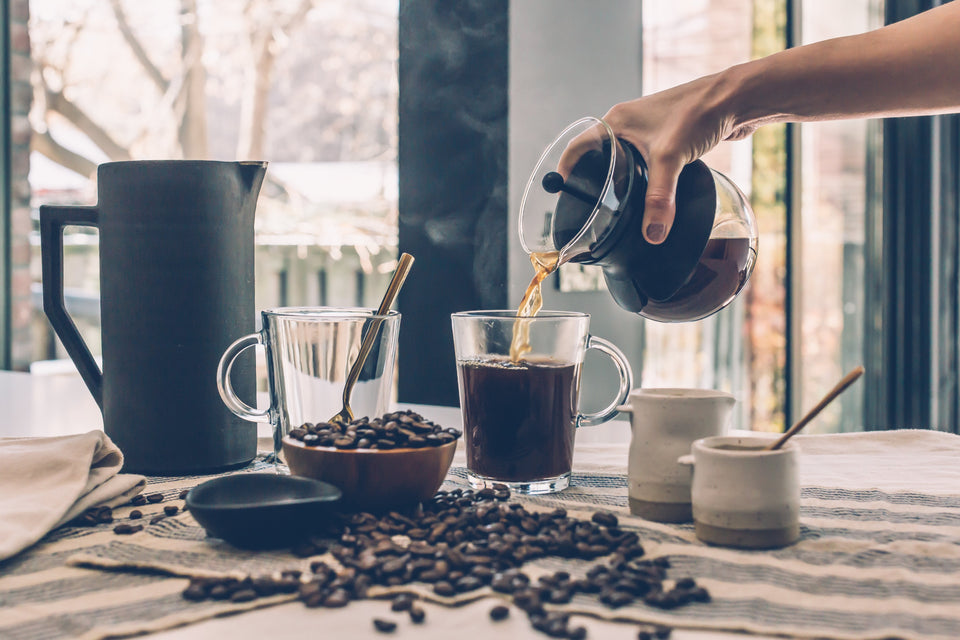We’ve created a handy cheat sheet to decode some of the most popular terms in speciality coffee…
Are you starting to get into the world of speciality coffee? Whether you're looking for your new favourite brew, a better understanding of the industry or want to feel more clued-up about the coffee you drink, this glossary can help.
Arabica

The term ‘arabica’ refers to a species of coffee tree known for producing high-quality coffee beans.
Arabica coffee comes from Coffea arabica beans, first originating in Ethiopia. Arabica is known as the most popular type of coffee and compared to other coffee species, including Robusta.
Arabica coffee beans are sweeter and have a richer flavour profile than Robusta coffee, giving them a depth of nuance in taste and aroma. They also have a higher acidity than other coffee varieties.
Artisan
Our favourite word. As well as our name, it is typical to hear ‘craft’ and ‘artisan’ thrown around about speciality coffee, and these terms are associated with roasting style.
You might also spot these words alongside ‘hand-roasted’, highlighting the expertise and knowledge behind the coffee-making process from bean to cup.
‘Artisan’ and ‘craft’ are also often associated with premium and high-quality coffee, much like many products within the food and beverage industry.
Aroma
You might think that coffee is all about flavour, but the smell emanating from the brewed cup is just as important. Over 40 aromatic compounds are in every roasted coffee bean and provide the first impression of the flavour.
A skilled coffee taster can spot key giveaways in the coffee’s aroma, including the beans' origin, freshness and roasting profile.
The term ‘aroma’ is not to be confused with ‘fragrance’ which refers to the smell of the dry, ground coffee beans before brewing.
Blend
The term ‘blend’ or ‘coffee blend’ means that the particular speciality coffee uses coffee beans originating from more than one place, so there isn't just one type of coffee variety in your brew. The coffee producers have created a blend with a delicious flavour profile that matches consumer tastes and preferences. This blend might include coffee beans from plant species grown at different altitudes, regions or countries.
Cupping

Coffee cupping is the art of coffee tasting, much like wine tasting. It involves the process of tasting brewed coffee to distinguish flavour profiles, characteristics, cultivars, countries of origin, aromas and quality of the batch.
Coffee cupping is a technique used by coffee producers and buyers around the world, rating coffees based on cleanness, sweetness, acidity, mouthfeel and aftertaste.
Micro-lot & Nano-lot
Micro-lot coffee refers to coffee beans from a single lot from one farm. The coffee beans are harvested separately from other coffees on the same farm, helping to make them traceable and retain their unique characteristics.
Nano-lot coffees are similar to micro-lot coffees but produced from even smaller plots of land. Farmers often use nano-lots for experimental techniques, such as anaerobic fermentation, allowing them to try new flavour profiles and increase prices.
Since both micro-lots and nano-lots produce smaller coffee amounts, they can be seen as exclusive and of better quality.
Single Origin
The phrase ‘single-origin coffee’ can be a little confusing, as it’s broader than you might think. This term essentially refers to coffee beans from a specific region, including a sub-region of a country or even the whole country itself. Most single-origin coffees are a blend of different coffee beans from one region.
Sustainability
Sustainability in speciality coffee often refers to reducing the coffee production’s environmental impact from farm to cup. This means looking at farming methods, land usage, deforestation and whether or not they can produce the same amount of coffee in the years to come.
Sustainability often ties in with traceability and transparency. Traceability looks at where the coffee comes from, while transparency refers to who is involved in the production process and fair pay.
Third-wave Coffee
The ‘third-wave coffee’ is a movement in coffee marketing focusing on high-quality beans and flavour profiles.
Coffee expert Trish Rothgeb first used it about coffee in a 2003 newsletter for the Roasters Guild, highlighting that the first wave was the coffee industry at the start of the 20th century, with the commercial rise of roasted and ground coffee. The second wave, in the 1970s, is also attributed to the dawn of coffee shops as we know them today, which made drinking coffee a social experience.
Starting in the early 2000s, the third wave took inspiration from Scandinavian consumers and their preference for lighter roasts and delicate flavours. The third wave also focuses on the technical skills involved in brewing coffee, supply chain transparency and the provenance of the beans.
So, the main difference between third-wave and speciality coffee? Perfect Daily Grind explains it as this: “Third-wave coffee is an experience. Speciality coffee is what we serve in that experience."
In other words, speciality coffee doesn’t just focus on the experience of the brew but the quality of the beans in the cup.
We hope this glossary has been a helpful introduction to the language of speciality coffee and that it comes in handy next time navigating the coffee aisle, cafe menu or even our collection at Artisan...
SHOP OUR COLLECTION

Are you sure?
By not selecting to receive marketing communications you'll lose most of the benefits associated with the QClub
Oooops, that's annoying.
Unfortunately one off product can't be purchased at the same time as subscription or pre-order purchases.
Please proceed using separate transactions.
Unfortunately subscriptions can't be purchased at the same time as one-off purchases.
Please proceed using separate transactions.
Unfortunately, pre-order products have to be purchased on their own.
Please proceed using separate transactions.
